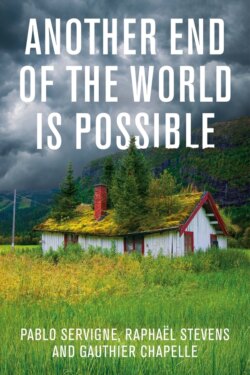Читать книгу Another End of the World is Possible - Pablo Servigne - Страница 10
Introduction Learning to live with it
ОглавлениеThe idea of a possible collapse no longer seems to worry us much. These days, the realization that global disasters are already happening is more and more widely accepted, as is the understanding that along with them comes the possibility of a global systemic collapse.
The monumental shocks caused by Fukushima, by the successive waves of refugees in Europe, by the terrorist attacks in Paris and Brussels, the large-scale disappearance of birds and insects, the Brexit vote and the election of Trump have seriously ruptured the sense of peaceful continuity that had been reassuring so many of us.
One of the barriers that stops us from accepting this idea of collapse is the caricature that has been made out of it. When we think of collapse, scenes from Hollywood disaster films rush up in front of us, feeding the vision of a single, unavoidable event that will suddenly annihilate everything with which we are familiar. We fear such a moment much as we fear the moment of transition from life to death in our own dying.
This is to forget that there are other, worse things about death. There is its anticipation, having to see others die, or seeing oneself suffer in the eyes of others. The collapse of our civilization will not be a single event or catastrophe, but a series of disastrous events (cyclones, industrial accidents, attacks, pandemics, droughts, etc.), taking place against a backdrop of equally destabilizing gradual changes (desertification, the disruption of the seasons, persistent pollution, the extinctions of species and of animal populations, and so on).
We envisage the collapse of what we call ‘thermo-industrial civilization’ as a process taking place in many different locations. It has already begun, but it has not yet reached its most critical phase, and we cannot say how long it will continue. It is both distant and close, slow-moving and fast, gradual and sudden. It will involve not only natural events, but also (and especially) political, economic and social disturbances, as well as events at a psychological level (such as shifts in collective consciousness).
This is no longer a Nostradamus-like prediction, nor is it yet another reason for a passive or nihilistic attitude. ‘Collapse’ is not a fashion, or a new label. However, this is likely to be a period that historians or archaeologists of future centuries will comes to label and to look upon as a coherent whole, or which future intelligent species will regard as a quite specific historical event.
If you think that we are exaggerating to get your attention, just remember what two climate scientists were saying in 2011 at a conference in Oxford about climate goals for the twenty-first century (and keep in mind that greenhouse gas emissions are directly proportional to economic activity). They recommended the following: The emerging countries had to start reducing their greenhouse gas emissions by 2030, then maintain this decline at 3 per cent annually. The developed countries had to reach their peak emissions in 2015 and then decline by 3 per cent annually.1 If these very ambitious goals were reached (and we already know that they are not being reached), then the world will have one chance in two to stay below an average temperature rise of 4°C by 2100 … which would already be monstrously catastrophic on a global scale. In 2017, BP and Shell were planning (internally, without informing their shareholders, let alone the public) for changes of the order of +5°C average by 2050.2
In recent history, there is no example of a society which has been able to reduce its emissions by more than 3 per cent over a short period. Such a reduction would cause an immediate economic recession, unless it had itself resulted from a collapse like that of the Soviet Union in the early 1990s or that of Venezuela after 2016.
For the Earth’s non-human population (fauna, flora, fungi and micro-organisms), the rise in temperature will mean mass slaughter. Some populations will just keep shrinking. Whole species will disappear forever. Populations of amphibians, of insects and birds in the countryside, of coral reefs, mammals, big fishes, whales and dolphins … The last male northern white rhinoceros of the North died in 2018, joining the list of imaginary animals which illustrate the stories we read at night to our children.
